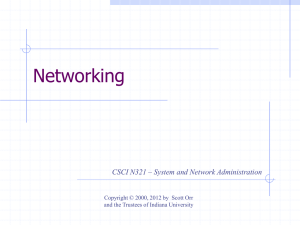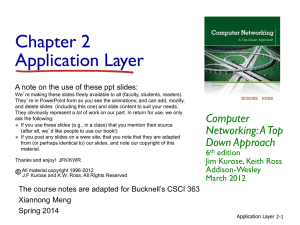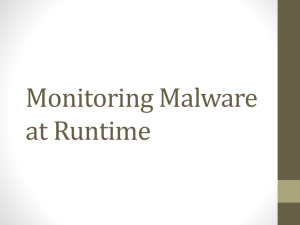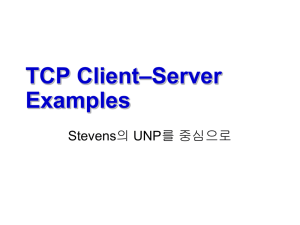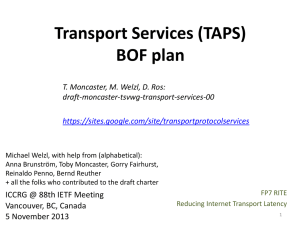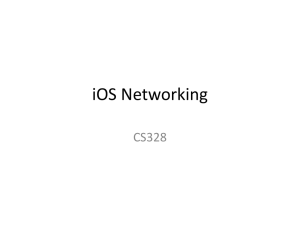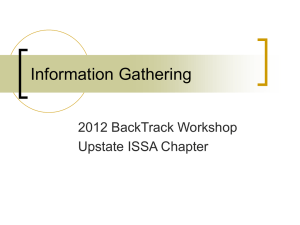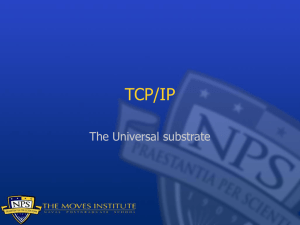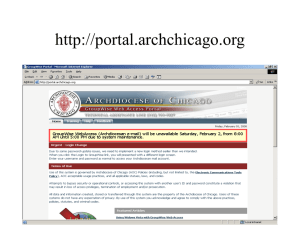Chapter 2. Application Layer
advertisement
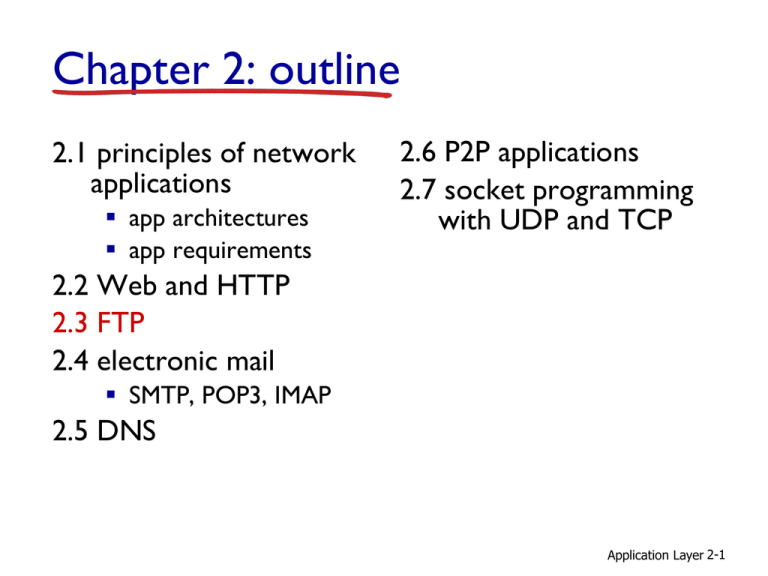
Chapter 2: outline
2.1 principles of network
applications
app architectures
app requirements
2.6 P2P applications
2.7 socket programming
with UDP and TCP
2.2 Web and HTTP
2.3 FTP
2.4 electronic mail
SMTP, POP3, IMAP
2.5 DNS
Application Layer 2-1
FTP: the file transfer protocol
FTP
user
interface
file transfer
FTP
client
user
at host
local file
system
FTP
server
remote file
system
transfer file to/from remote host
client/server model
client: side that initiates transfer (either to/from remote)
server: remote host
ftp: RFC 959
ftp server: port 21
Application Layer 2-2
FTP: separate control, data connections
FTP client contacts FTP server
at port 21, using TCP
client authorized over control
connection
client browses remote
directory, sends commands
over control connection
when server receives file
transfer command, server
opens 2nd TCP data
connection (for file) to client
after transferring one file,
server closes data connection
TCP control connection,
server port 21
FTP
client
TCP data connection,
server port 20
FTP
server
server opens another TCP
data connection to transfer
another file
control connection: “out of
band”
FTP server maintains
“state”: current directory,
earlier authentication
Application Layer 2-3
FTP commands, responses
sample commands:
sent as ASCII text over
control channel
USER username
PASS password
LIST return list of file in
current directory
RETR filename
retrieves (gets) file
STOR filename stores
(puts) file onto remote
host
sample return codes
status code and phrase (as
in HTTP)
331 Username OK,
password required
125 data
connection
already open;
transfer starting
425 Can’t open
data connection
452 Error writing
file
Application Layer 2-4
Chapter 2: outline
2.1 principles of network
applications
app architectures
app requirements
2.6 P2P applications
2.7 socket programming
with UDP and TCP
2.2 Web and HTTP
2.3 FTP
2.4 electronic mail
SMTP, POP3, IMAP
2.5 DNS
Application Layer 2-5
Electronic mail
outgoing
message queue
user mailbox
Three major components:
user agents
mail servers
simple mail transfer
protocol: SMTP
User Agent
a.k.a. “mail reader”
composing, editing, reading
mail messages
e.g., Outlook, Thunderbird,
iPhone mail client
outgoing, incoming
messages stored on server
user
agent
mail
server
user
agent
SMTP
mail
server
user
agent
SMTP
SMTP
mail
server
user
agent
user
agent
user
agent
Application Layer 2-6
Electronic mail: mail servers
mail servers:
mailbox contains incoming
messages for user
message queue of outgoing
(to be sent) mail messages
SMTP protocol between
mail servers to send email
messages
client: sending mail
server
“server”: receiving mail
server
user
agent
mail
server
user
agent
SMTP
mail
server
user
agent
SMTP
SMTP
mail
server
user
agent
user
agent
user
agent
Application Layer 2-7
Electronic Mail: SMTP [RFC 2821]
uses TCP to reliably transfer email message from
client to server, port 25
three phases of transfer
handshaking (greeting)
transfer of messages
closure
command/response interaction (like HTTP, FTP)
commands: ASCII text
response: status code and phrase
messages must be in 7-bit ASCI
Application Layer 2-8
Scenario: Alice sends message to Bob
4) SMTP client sends Alice’s
message over the TCP
connection
5) Bob’s mail server places the
message in Bob’s mailbox
6) Bob invokes his user agent
to read message
1) Alice uses UA to compose
message “to”
bob@someschool.edu
2) Alice’s UA sends message
to her mail server; message
placed in message queue
3) client side of SMTP opens
TCP connection with Bob’s
mail server
1 user
agent
2
mail
server
3
Alice’s mail server
user
agent
mail
server
4
6
5
Bob’s mail server
Application Layer 2-9
SMTP: final words
SMTP uses persistent
connections
SMTP requires message
(header & body) to be in
7-bit ASCII
=> MIME (multi-purpose
internet mail extension) is
developed to send nonASCII code
comparison with HTTP:
HTTP: pull
SMTP: push
Application Layer 2-10
Mail message format
SMTP: protocol for
exchanging email msgs
RFC 822: standard for text
message format:
header lines, e.g.,
To:
From:
Subject:
header
blank
line
body
Body: the “message”
ASCII characters only
Application Layer 2-11
Mail access protocols
user
agent
SMTP
SMTP
mail access
protocol
user
agent
(e.g., POP,
IMAP)
sender’s mail
server
receiver’s mail
server
SMTP: delivery/storage to receiver’s server
mail access protocol: retrieval from server
POP: Post Office Protocol [RFC 1939]: authorization,
download
IMAP: Internet Mail Access Protocol [RFC 1730]: more
features, including manipulation of stored msgs on
server
HTTP: gmail, Hotmail, Yahoo! Mail, etc.
Application Layer 2-12
POP3 (more) and IMAP
more about POP3
POP3 is “download and
delete” mode
Bob cannot re-read email if he changes
client
IMAP
keeps all messages in one
place: at server
allows user to organize
messages in folders
Application Layer 2-13
Chapter 2: outline
2.1 principles of network
applications
app architectures
app requirements
2.6 P2P applications
2.7 socket programming
with UDP and TCP
2.2 Web and HTTP
2.3 FTP
2.4 electronic mail
SMTP, POP3, IMAP
2.5 DNS
Application Layer 2-14
DNS: domain name system
people: many identifiers:
SSN, name, passport #
Internet hosts, routers:
IP address (32 bit) used for addressing
datagrams
“name”, e.g.,
www.yahoo.com used by humans
Q: how to map between IP
address and name, and
vice versa ?
Domain Name System:
distributed database
implemented in hierarchy of
many name servers
application-layer protocol: hosts,
name servers communicate to
resolve names (address/name
translation)
note: core Internet function,
implemented as applicationlayer protocol
complexity at network’s
“edge”
Application Layer 2-15
DNS: services, structure
DNS services
hostname to IP address
translation
why not centralize DNS?
single point of failure
traffic volume
distant centralized database
maintenance
A: doesn’t scale!
Application Layer 2-16
DNS: a distributed, hierarchical database
Root DNS Servers
…
com DNS servers
yahoo.com
amazon.com
DNS servers DNS servers
…
org DNS servers
pbs.org
DNS servers
edu DNS servers
poly.edu
umass.edu
DNS serversDNS servers
client wants IP for www.amazon.com; 1st approx:
client queries root server to find com DNS server
client queries .com DNS server to get amazon.com DNS server
client queries amazon.com DNS server to get IP address for
www.amazon.com
Application Layer 2-17
DNS: root name servers
contacted by local name server that can not resolve name
root name server:
contacts authoritative name server if name mapping not known
gets mapping
returns mapping to local name server
c. Cogent, Herndon, VA (5 other sites)
d. U Maryland College Park, MD
h. ARL Aberdeen, MD
j. Verisign, Dulles VA (69 other sites )
e. NASA Mt View, CA
f. Internet Software C.
Palo Alto, CA (and 48 other
sites)
a. Verisign, Los Angeles CA
(5 other sites)
b. USC-ISI Marina del Rey, CA
l. ICANN Los Angeles, CA
(41 other sites)
g. US DoD Columbus,
OH (5 other sites)
k. RIPE London (17 other sites)
i. Netnod, Stockholm (37 other sites)
m. WIDE Tokyo
(5 other sites)
13 root name
“servers”
worldwide
Application Layer 2-18
TLD, authoritative servers
top-level domain (TLD) servers:
responsible for com, org, net, edu, gov, and all top-level
country domains, e.g.: uk, fr, ca, kr, mn
authoritative DNS servers:
organization’s own DNS server(s), providing
authoritative hostname to IP mappings for organization’s
named hosts
can be maintained by organization or service provider
Application Layer 2-19
Local DNS name server
does not strictly belong to hierarchy
each ISP (residential ISP, company, university) has
one
also called “default name server”
when host makes DNS query, query is sent to its
local DNS server
has local cache of recent name-to-address translation
pairs (but may be out of date!)
acts as proxy, forwards query into hierarchy
Application Layer 2-20
DNS name
resolution example
root DNS server
2
host at cis.poly.edu
wants IP address for
gaia.cs.umass.edu
contacted server
replies with name of
server to contact
“I don’t know this
name, but ask this
server”
3
TLD DNS server
4
5
local DNS server
dns.poly.edu
1
8
7
6
authoritative DNS server
dns.cs.umass.edu
requesting host
cis.poly.edu
gaia.cs.umass.edu
Application Layer 2-21
DNS: caching, updating records
once (any) name server learns mapping, it caches
mapping
cache entries timeout (disappear) after some time (TTL)
TLD servers typically cached in local name servers
• thus root name servers not often visited
cached entries may be out-of-date
if name host changes IP address, may not be known
Internet-wide until all TTLs expire
update/notify mechanisms proposed IETF standard
RFC 2136
Application Layer 2-22
Chapter 2: outline
2.1 principles of network
applications
app architectures
app requirements
2.6 P2P applications
2.7 socket programming
with UDP and TCP
2.2 Web and HTTP
2.3 FTP
2.4 electronic mail
SMTP, POP3, IMAP
2.5 DNS
Application Layer 2-23
P2P file distribution: BitTorrent
file divided into 256Kb chunks
peers in torrent send/receive file chunks
tracker: tracks peers
participating in torrent
torrent: group of peers
exchanging chunks of a file
Alice arrives …
… obtains list
of peers from tracker
… and begins exchanging
file chunks with peers in torrent
Application Layer 2-24
P2P file distribution: BitTorrent
peer joining torrent:
has no chunks, but will
accumulate them over time
from other peers
registers with tracker to get
list of peers, connects to
subset of peers
(“neighbors”)
while downloading, peer uploads chunks to other peers
peer may change peers with whom it exchanges chunks
peers may come and go
once peer has entire file, it may (selfishly) leave or remain in
torrent
Application Layer 2-25
BitTorrent: requesting, sending file chunks
requesting chunks:
at any given time, different
peers have different subsets
of file chunks
periodically, Alice asks each
peer for list of chunks that
they have
Alice requests missing
chunks from peers, rarest
first
sending chunks: tit-for-tat
Alice sends chunks to those
four peers currently sending her
chunks at highest rate
other peers are choked by Alice
(do not receive chunks from her)
re-evaluate top 4 every10 secs
every 30 secs: randomly select
another peer, starts sending
chunks
“optimistically unchoke” this peer
newly chosen peer may join top 4
Application Layer 2-26
BitTorrent: tit-for-tat
(1) Alice “optimistically unchokes” Bob
(2) Alice becomes one of Bob’s top-four providers; Bob reciprocates
(3) Bob becomes one of Alice’s top-four providers
higher upload rate: find better
trading partners, get file faster !
Application Layer 2-27
Chapter 2: outline
2.1 principles of network
applications
app architectures
app requirements
2.6 P2P applications
2.7 socket programming
with UDP and TCP
2.2 Web and HTTP
2.3 FTP
2.4 electronic mail
SMTP, POP3, IMAP
2.5 DNS
Application Layer 2-28
Socket programming
goal: learn how to build client/server applications that
communicate using sockets
socket: door between application process and endend-transport protocol
application
process
socket
application
process
transport
transport
network
network
link
physical
Internet
link
controlled by
app developer
controlled
by OS
physical
Application Layer 2-29
Socket programming
Two socket types for two transport services:
UDP: unreliable datagram
TCP: reliable, byte stream-oriented
Application Example:
1.
Client reads a line of characters (data) from its
keyboard and sends the data to the server.
2.
The server receives the data and converts
characters to uppercase.
3.
The server sends the modified data to the client.
4.
The client receives the modified data and displays
the line on its screen.
Application Layer 2-30
Socket programming with UDP
UDP: no “connection” between client & server
no handshaking before sending data
sender explicitly attaches IP destination address and
port # to each packet
rcvr extracts sender IP address and port# from
received packet
UDP: transmitted data may be lost or received
out-of-order
Application viewpoint:
UDP provides unreliable transfer of groups of bytes
(“datagrams”) between client and server
Application Layer 2-31
Client/server socket interaction: UDP
server (running on serverIP)
create socket, port= x:
serverSocket =
socket(AF_INET,SOCK_DGRAM)
read datagram from
serverSocket
write reply to
serverSocket
specifying
client address,
port number
client
create socket:
clientSocket =
socket(AF_INET,SOCK_DGRAM)
Create datagram with server IP and
port=x; send datagram via
clientSocket
read datagram from
clientSocket
close
clientSocket
Application 2-32
Example app: UDP client
Python UDPClient
include Python’s socket
library
from socket import *
serverName = ‘hostname’
serverPort = 12000
create UDP socket for
server
clientSocket = socket(socket.AF_INET,
socket.SOCK_DGRAM)
get user keyboard
input
message = raw_input(’Input lowercase sentence:’)
Attach server name, port to
message; send into socket
clientSocket.sendto(message,(serverName, serverPort))
read reply characters from
socket into string
modifiedMessage, serverAddress =
print out received string
and close socket
print modifiedMessage
clientSocket.recvfrom(2048)
clientSocket.close()
Application Layer 2-33
Example app: UDP server
Python UDPServer
from socket import *
serverPort = 12000
create UDP socket
serverSocket = socket(AF_INET, SOCK_DGRAM)
bind socket to local port
number 12000
serverSocket.bind(('', serverPort))
print “The server is ready to receive”
loop forever
while 1:
Read from UDP socket into
message, getting client’s
address (client IP and port)
message, clientAddress = serverSocket.recvfrom(2048)
send upper case string
back to this client
serverSocket.sendto(modifiedMessage, clientAddress)
modifiedMessage = message.upper()
Application Layer 2-34
Socket programming with TCP
client must contact server
server process must first be
running
server must have created
socket (door) that
welcomes client’s contact
client contacts server by:
Creating TCP socket,
specifying IP address, port
number of server process
when client creates socket:
client TCP establishes
connection to server TCP
when contacted by client,
server TCP creates new socket
for server process to
communicate with that
particular client
allows server to talk with
multiple clients
source port numbers used
to distinguish clients
(more in Chap 3)
application viewpoint:
TCP provides reliable, in-order
byte-stream transfer (“pipe”)
between client and server
Application Layer 2-35
Client/server socket interaction: TCP
client
server (running on hostid)
create socket,
port=x, for incoming
request:
serverSocket = socket()
wait for incoming
TCP
connection request
connectionSocket = connection
serverSocket.accept()
read request from
connectionSocket
write reply to
connectionSocket
close
connectionSocket
setup
create socket,
connect to hostid, port=x
clientSocket = socket()
send request using
clientSocket
read reply from
clientSocket
close
clientSocket
Application Layer 2-36
Example app: TCP client
Python TCPClient
from socket import *
serverName = ’servername’
create TCP socket for
server, remote port 12000
serverPort = 12000
clientSocket = socket(AF_INET, SOCK_STREAM)
clientSocket.connect((serverName,serverPort))
sentence = raw_input(‘Input lowercase sentence:’)
No need to attach server
name, port
clientSocket.send(sentence)
modifiedSentence = clientSocket.recv(1024)
print ‘From Server:’, modifiedSentence
clientSocket.close()
Application Layer 2-37
Example app: TCP server
Python TCPServer
create TCP welcoming
socket
server begins listening for
incoming TCP requests
loop forever
server waits on accept()
for incoming requests, new
socket created on return
read bytes from socket (but
not address as in UDP)
close connection to this
client (but not welcoming
socket)
from socket import *
serverPort = 12000
serverSocket = socket(AF_INET,SOCK_STREAM)
serverSocket.bind((‘’,serverPort))
serverSocket.listen(1)
print ‘The server is ready to receive’
while 1:
connectionSocket, addr = serverSocket.accept()
sentence = connectionSocket.recv(1024)
capitalizedSentence = sentence.upper()
connectionSocket.send(capitalizedSentence)
connectionSocket.close()
Application Layer 2-38
Chapter 2: summary
our study of network apps now complete!
application architectures
client-server
P2P
application service
requirements:
reliability, bandwidth, delay
Internet transport service
model
connection-oriented,
reliable: TCP
unreliable, datagrams: UDP
specific protocols:
HTTP
FTP
SMTP, POP, IMAP
DNS
P2P: BitTorrent, DHT
socket programming: TCP,
UDP sockets
Application Layer 2-39
Chapter 2: summary
most importantly: learned about protocols!
typical request/reply
message exchange:
client requests info or
service
server responds with
data, status code
message formats:
headers: fields giving
info about data
data: info being
communicated
important themes:
control vs. data msgs
in-band, out-of-band
centralized vs. decentralized
stateless vs. stateful
reliable vs. unreliable msg
transfer
“complexity at network
edge”
Application Layer 2-40
Homework
1. Read RFC 959 for FTP. List all of the client
commands that are supported by the RFC.
2. Print out the header of an e-mail message you
have recently received. How many “Received:”
header lines are there? Analyze each of the
header lines in the message.
Application Layer 2-41


